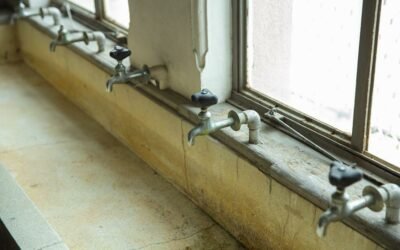Do you want to know what causes charcoal mold in your home? Look no further! In this article, we'll explore the ins and outs of charcoal mold, including its causes, signs, and symptoms.
You'll also discover effective prevention and treatment methods to keep your space mold-free. So, if you're ready to tackle this pesky problem head-on, keep reading to arm yourself with the knowledge you need.
Key Takeaways
- Charcoal mold, also known as sooty mold, is a fungal disease that affects plants.
- It is a secondary infection that occurs as a result of other issues, such as aphid or whitefly infestations.
- The mold blocks sunlight from reaching the leaves, inhibiting photosynthesis and reducing the plant's energy production.
- Warm and humid environments are favorable for the proliferation of aphids and scale insects, which contribute to the growth of charcoal mold.
What Is Charcoal Mold
If you have ever wondered what charcoal mold is, you're about to find out. Charcoal mold, also known as sooty mold, is a fungal disease that affects plants. It gets its name from its appearance, as it looks like a layer of black soot or charcoal covering the leaves, stems, and branches of the infected plant.
This mold isn't an actual pathogen that directly harms plants, but rather a secondary infection that occurs as a result of other issues, such as aphid or whitefly infestations. These insects excrete a sugary substance called honeydew, which provides the perfect breeding ground for the mold spores to grow and thrive.
The presence of charcoal mold on a plant can have several negative effects. Firstly, it can block sunlight from reaching the leaves, inhibiting photosynthesis and reducing the plant's ability to produce energy. Secondly, it can interfere with the plant's ability to respire, as the mold layer can cover the stomata, which are responsible for gas exchange. This can lead to reduced growth and overall decline in the plant's health. Additionally, the black layer of mold can be aesthetically unappealing and diminish the plant's visual appeal.
In order to control charcoal mold, it's important to address the underlying issue that's attracting the insects producing the honeydew. This may involve treating the plant for aphids or whiteflies, as well as implementing cultural practices such as pruning to increase air circulation and reduce humidity. In some cases, the mold can be washed off with a gentle soap and water solution. However, it's crucial to monitor the plant closely and take appropriate action to prevent future infestations and mold growth.
Causes of Charcoal Mold
To understand the causes of charcoal mold, you need to identify the factors that attract the insects responsible for producing honeydew. These insects, such as aphids and scale insects, feed on plants' sap and excrete a sugary substance called honeydew. Charcoal mold, also known as sooty mold, is a black fungus that grows on the honeydew excreted by these insects.
Here are three factors that can attract these insects and contribute to the development of charcoal mold:
- Plant species: Certain plant species are more susceptible to infestations by aphids and scale insects. These insects are drawn to plants with high levels of sap or nectar production, as they provide a plentiful food source.
- Environmental conditions: Warm and humid environments are favorable for the proliferation of aphids and scale insects. These conditions provide the ideal climate for their reproduction and growth, leading to increased honeydew production.
- Presence of ants: Ants have a mutualistic relationship with aphids and scale insects. They protect these insects from predators and parasites in exchange for honeydew. Ants will actively farm and defend colonies of honeydew-producing insects, further exacerbating the problem.
Signs and Symptoms of Charcoal Mold
Once you have identified the causes of charcoal mold, you can now recognize the signs and symptoms of this black fungus.
Charcoal mold, also known as Aspergillus niger, can manifest in various ways, depending on the severity of the infestation and the individual's sensitivity to the spores.
One of the most common signs is the appearance of black, powdery patches on surfaces, particularly in damp and humid areas. These patches may spread and grow over time if not addressed promptly.
Additionally, you may notice a musty or earthy odor in the affected areas, which is caused by the volatile organic compounds produced by the mold.
Some individuals may also experience respiratory symptoms, such as coughing, wheezing, and shortness of breath, particularly if they've pre-existing respiratory conditions or compromised immune systems.
Skin irritation and allergic reactions, such as itching, redness, and rashes, may occur upon contact with the spores.
In some cases, prolonged exposure to charcoal mold can even lead to more serious health issues, such as chronic sinusitis or fungal infections in the lungs.
Therefore, it's crucial to address and mitigate the signs and symptoms of charcoal mold promptly to prevent further complications.
Prevention and Treatment of Charcoal Mold
To prevent and treat charcoal mold, you should take proactive measures to eliminate moisture and improve ventilation in your living environment. Here are three important steps you can take:
- Control moisture:
- Moisture is the primary factor that promotes the growth of charcoal mold.
- To prevent its formation, make sure to fix any leaks or water damage in your home.
- Regularly check for and address any sources of moisture, such as plumbing leaks, condensation, or high humidity levels.
- Properly ventilate areas prone to moisture, such as bathrooms, kitchens, and basements, by using exhaust fans or opening windows.
- Improve air circulation:
- Good air circulation helps to prevent the buildup of moisture and promotes drying.
- Ensure that your home has adequate ventilation by keeping doors and windows open whenever possible.
- Use fans to increase airflow in areas with poor ventilation.
- Consider using dehumidifiers in damp areas to reduce humidity levels.
- Maintain cleanliness:
- Regularly clean and disinfect areas susceptible to mold growth, such as bathrooms, kitchens, and basements.
- Use mold-resistant products or cleaners to inhibit mold growth.
- Keep surfaces dry and remove any visible moisture promptly.
- Regularly clean and replace air filters in HVAC systems to prevent the circulation of mold spores.
Conclusion and Final Thoughts
In conclusion, by following these proactive measures, you can effectively prevent and treat charcoal mold in your living environment.
By maintaining proper ventilation, you can reduce moisture levels and discourage the growth of mold. Ensure that all areas prone to moisture, such as bathrooms and kitchens, are well-ventilated to prevent the accumulation of excess moisture. Regularly clean and dry these areas to prevent mold from colonizing.
Additionally, using dehumidifiers in damp areas can help to control humidity levels and inhibit mold growth. It's important to promptly repair any leaks or water damage in your home to prevent the development of mold. This includes fixing plumbing issues, sealing cracks in walls or windows, and addressing any roof leaks.
Regularly inspecting your home for signs of mold, such as musty odors or visible growth, can help you identify and treat the problem before it becomes extensive. If you do find mold, it's crucial to remove it properly using appropriate cleaning solutions and protective gear. Remember to address the underlying cause of the mold growth to prevent recurrence.
Conclusion
In conclusion, charcoal mold is a type of mold that can develop in areas with high humidity and poor ventilation. It's caused by the growth of mold spores on charcoal surfaces.
Common signs of charcoal mold include discoloration, musty odor, and respiratory symptoms.
Prevention involves maintaining proper ventilation and reducing moisture levels.
Treatment includes cleaning affected areas with a bleach solution.
Overall, understanding the causes, signs, and prevention methods can help effectively manage charcoal mold.






0 Comments